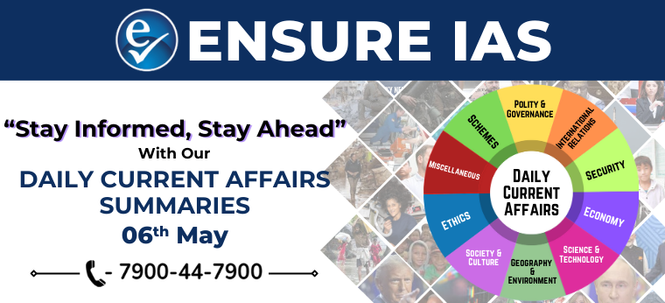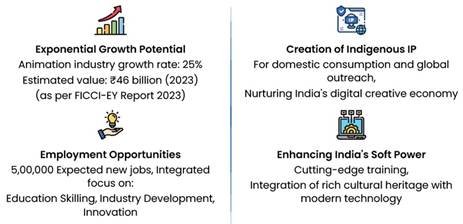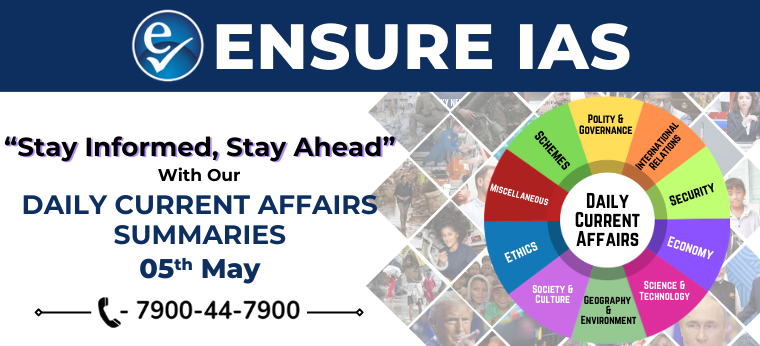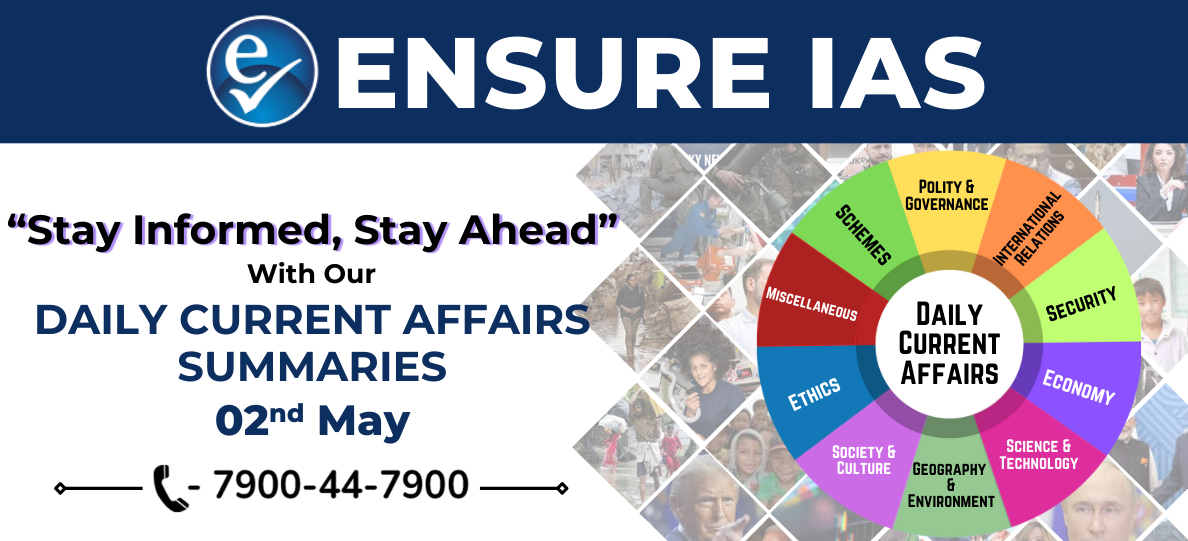- Courses
- GS Full Course 1 Year
- GS Full Course 2 Year
- GS Full Course 3 Year
- GS Full Course Till Selection
- Online Program
- GS Recorded Course
- NCERT (Recorded 500+ Hours)
- Polity Recorded Course
- Geography Recorded Course
- Economy Recorded Course
- AMAC Recorded Course
- Modern India, Post Independence & World History
- Environment Recoded Course
- Governance Recoded Course
- Science & Tech. Recoded Course
- International Relations and Internal Security Recorded Course
- Disaster Management Module Course
- Ethics Recoded Course
- Essay Recoded Course
- Current Affairs Recoded Course
- CSAT
- 5 LAYERED ARJUNA Mentorship
- Public Administration Optional
- ABOUT US
- OUR TOPPERS
- TEST SERIES
- FREE STUDY MATERIAL
- VIDEOS
- CONTACT US
Daily Current Affairs Summary 6th MAY 2025
Daily Current Affairs Summary 6th MAY 2025

Report Submitted for Framework on Repairability Index (RI) in Mobile and Electronic Sector
- A committee chaired by Bharat Khera has submitted its report to the Department of Consumer Affairs (DoCA) on creating a Repairability Index (RI) framework.
- The framework aims to bring transparency and consumer awareness in the electronics sector, especially mobile devices.
What Does the RI Framework Recommend?
- Original Equipment Manufacturers (OEMs) must self-declare the RI based on standardized scoring guidelines laid down in the framework.
- The declared RI must be clearly visible at the point of sale, on E-commerce platforms, and through QR codes on product packaging.
- In the initial phase, the committee has prioritized smartphones and tablets for implementation of the RI.
- The RI is calculated using six core parameters, each assigned specific scoring criteria and weightages.
- After aggregating the weighted scores of priority parts, the final RI is presented on a five-point numeric scale.

Components of Repairability Index
Why is the RI Important?
- Better Repair Access: Complaints related to mobiles and tablets increased from 19,057 in 2022-2023 to 22,864 in 2024-2025, indicating growing consumer dissatisfaction.
- Supports Sustainable Lifestyle: The RI promotes the LiFE (Lifestyle for Environment) movement by encouraging sustainable consumption and reduced electronic waste.
- Counters Planned Obsolescence: It addresses the practice where devices are intentionally designed to have short lifespans and frequent replacements.
- Generates Employment: By enabling and legalizing third-party repairs, the RI can create jobs in local repair services.
What is the 'Right to Repair' Movement?
- The Right to Repair advocates that manufacturers should provide spare parts, tools, and repair manuals to customers and repair shops.
- This initiative aims to extend the life of products and reduce dependency on company service centers.
- To support this cause, the Right to Repair Portal India was launched by DoCA in 2022, making repair-related information accessible to consumers.
Centre Launches Indian Institute of Creative Technology (IICT) to Boost AVGC-XR Sector
- The Government of India has launched the Indian Institute of Creative Technology (IICT) as a major step to develop the AVGC-XR (Animation, Visual Effects, Gaming, Comics & Extended Reality) ecosystem.
- The initiative is spearheaded by the Ministry of Information and Broadcasting in collaboration with FICCI and CII.
What is the Indian Institute of Creative Technology (IICT)?
- IICT is envisioned as a National Centre of Excellence (NCoE), fully focused on the AVGC-XR sector.
- It will work towards advancing education, training, and industry-academia collaboration in this growing creative technology domain.
- The institute will adopt the model of IITs and IIMs to become a global hub for high-quality education and professional training in AVGC-XR.
- Extended Reality (XR) technologies, which include Virtual Reality (VR), Augmented Reality (AR), and Mixed Reality (MR), will be key focus areas under IICT.
Current Status of the AVGC-XR Sector
- The global AVGC-XR industry was valued at over $366 billion in 2021, showing massive global demand and innovation.
- However, India’s contribution to this market is currently less than 1%, indicating significant untapped potential.
- Projections suggest the Indian AVGC-XR market could grow to $26 billion by 2030 with the right ecosystem and support.
- Karnataka, India’s established IT hub, is also emerging as a leader in the AVGC-XR sector.

Benefits of NCOE National Centre of Excellence
Key Growth Drivers for AVGC-XR in India
- Surge in OTT Consumption: India had about 547 million OTT users in 2024, achieving a penetration rate of 38.4%.
- Expanding Smartphone & Internet Reach: Over 900 million internet users are expected in India by 2025, mostly from rural regions, as per the IAMAI-Kantar report.
- Diverse Use-Cases: Animation and VFX are increasingly used in gaming, education technology (EdTech), architecture, and more.
- Rapid Tech Advancements: Investment in cutting-edge technologies like AR and VR is rising steadily each year.
- Supporting Infrastructure: Growth of 5G networks, increased R&D spending, and policy support are boosting the sector.
Biological Diversity (Access, Benefit Sharing) Regulations, 2025 Notified
- The National Biodiversity Authority (NBA) has officially notified the Biological Diversity Regulations, 2025.
- These new rules are framed under the Biological Diversity Act (BDA), 2002.
- They replace the earlier 2014 regulations to align with emerging global and domestic biodiversity priorities.
- The rules focus on equitable benefit sharing from the use of biological resources and associated knowledge, including Digital Sequence Information (DSI).
What is Access and Benefit Sharing (ABS)?
- ABS governs how genetic resources are accessed and how benefits from their use are shared fairly.
- It ensures providers of biological resources—individuals, communities, or countries—receive fair compensation from users.
- ABS is based on international commitments under the Convention on Biological Diversity (CBD).
- Key instruments under CBD include the Bonn Guidelines and the legally binding Nagoya Protocol (2010).
- In 2024, the CBD COP16 adopted a Multilateral Mechanism specifically for the use of Digital Sequence Information (DSI).
|
Annual Turnover of the Person (in INR) |
Benefit Sharing Amount Payable (as % of annual gross ex-factory sale price, excluding govt. taxes) |
|
Up to ₹5 crore |
Nil |
|
Above ₹5 crore to ₹50 crore |
0.2% |
|
Above ₹50 crore to ₹250 crore |
0.4% |
|
Above ₹250 crore |
0.6% |
Key Features of the 2025 Regulations
1. Prior Informed Consent (PIC)
- Individuals or industries seeking to access biological resources must inform and seek approval from the NBA in advance.
- However, access to cultivated medicinal plants notified under BDA 2002 is exempt from this requirement.
2. Benefit Sharing Based on Turnover
- The new rules define benefit-sharing slabs based on the annual turnover of the user entity.
- Entities with turnover exceeding ₹1 crore must file annual statements detailing the biological resources used.
3. Resources with High Conservation/Economic Value
- For high-value resources like red sanders or agarwood, benefit-sharing starts at a minimum of 5% of the sale, auction, or purchase price.
- In cases of commercial exploitation, the benefit share may go beyond 20%, depending on the resource’s significance.
4. Commercialization of Intellectual Property Rights (IPR)
- Applicants utilizing biological resources for IPR purposes must compensate the NBA through monetary or agreed non-monetary benefits.
- This ensures that innovation using India’s biological wealth returns value to the country and local communities.
Mediation: Tool to Achieve Viksit Bharat 2047 Vision
- The President of India emphasized the crucial role of mediation in realizing the goal of Viksit Bharat by 2047.
- He was addressing the First National Conference on Mediation, held in New Delhi.
- The event also witnessed the launch of the Mediation Association of India to institutionalize and promote mediation across the country.
- The Association will work towards making mediation a preferred, structured, and easily accessible method for resolving disputes.
What is Mediation?
- Mediation is a form of Alternative Dispute Resolution (ADR) alongside Arbitration and Conciliation.
- It involves a neutral third party (mediator) helping the disputing parties communicate and reach a voluntary settlement.
- Between 2016 and early 2025, over 7,57,173 cases were successfully resolved through mediation in India.
How Does Mediation Differ from Arbitration and Conciliation?
|
Aspect |
Mediation |
Arbitration |
Conciliation |
|
Nature |
Voluntary and informal |
Formal and legally binding |
Voluntary and informal |
|
Third Party Role |
Mediator facilitates dialogue without imposing a decision |
Arbitrator acts like a judge and delivers a binding verdict |
Conciliator suggests solutions and may propose a settlement |
|
Binding Decision |
No |
Yes |
No |
|
Enforceability |
Not enforceable unless converted into a contract |
Legally binding and enforceable |
Not enforceable unless parties agree to it |
DRDO Successfully Tests Stratospheric Airship Platform (SAP)
- The Defence Research and Development Organisation (DRDO) has conducted the first successful flight trials of the Stratospheric Airship Platform (SAP).
- With this achievement, India joins a select group of nations possessing indigenous high-altitude platform systems.
- The SAP has been developed by Aerial Delivery Research and Development Establishment (ADRDE), located in Agra.
- It is aimed at boosting India’s earth observation and Intelligence, Surveillance & Reconnaissance (ISR) capabilities.
What is the Stratospheric Airship Platform (SAP)?
- SAP is a high-altitude, unmanned airship designed to function in the stratosphere, typically between 17 to 22 kilometers above the Earth’s surface.
- It operates as a High-Altitude Pseudo-Satellite (HAPS), offering extended-duration missions from high altitudes.
- HAPS platforms are broadly divided into aerodynamic types (like fixed-wing aircraft) and aerostatic types (like balloons and airships).
- SAP belongs to the aerostatic category, using helium gas to generate buoyant lift.
- It is primarily solar-powered, with onboard batteries to ensure continuous operation during nighttime.
Why is SAP Strategically Important?
- Unlike conventional satellites or aircraft, SAP can hover over a specific location for days or even weeks.
- It provides persistent surveillance, real-time communication, and long-duration observation over targeted zones.
- It is equipped to carry various payloads, including imaging sensors, radars, and telecom equipment.
- These capabilities make SAP highly valuable for border monitoring, disaster management, and intelligence gathering.
- It effectively bridges the operational gap between drones and satellites, offering space-like services with faster deployment, greater flexibility, and lower operational costs.
Di(2-ethylhexyl) Phthalate (DEHP): A Chemical of Concern
- A recent study has established a potential link between exposure to DEHP and increased risk of heart disease-related deaths.
- DEHP stands for Di(2-ethylhexyl) Phthalate, also commonly known as bis(2-ethylhexyl) phthalate.
- It is an industrial chemical widely used to enhance flexibility in plastic products.
- DEHP appears as a colorless liquid with little to no odor, making it undetectable by smell.
- It has low volatility, meaning it does not evaporate easily, even in areas close to manufacturing facilities.
- The chemical is more soluble in substances like gasoline, paint removers, and oils than in water.
- Due to its properties, DEHP is found in numerous everyday items, including food packaging materials, toys, and personal care products.
- It is also commonly present in medical devices, such as IV tubing and blood bags, raising exposure risks in healthcare settings.
- Products like shampoos, lotions, and other cosmetic items may also contain trace amounts of DEHP.
- Health studies have identified that DEHP poses toxic risks particularly to the developing fetus and the male reproductive system.
- Continuous or high-level exposure to DEHP is now being studied for its potential link to cardiovascular health impacts, including fatal heart conditions.
Chenab River
India has reduced the flow of water through the Baglihar Dam after the Indus Treaty suspension.
- Bahlihar is a run-of-river Hydropower Project, located on the Chenab River in Jammu & Kashmir.
About Chenab river
- It is the largest tributary of the Indus.
- It joins Indus at Mithankot (Pakistan).
- Source: It is formed by the confluence of two streams, Chandra and Bhaga
- These streams rise on the opposite sides of the Baralacha pass of Himachal Pradesh.
- It is also known as Chandrabhaga.
- The Jhelum joins the Chenab near Jhang in Pakistan.
- Key Tributaries: Miyar Nalla, Sohal, Marusudar, Lidrar, etc.
Agriphotovoltaics (APVs)
Recently, it has been highlighted that Agriphotovoltaics (APVs) provide a model that maximises land-use efficiency and augments farmers’ income.
About APVs (Agrivoltaics or Solar farming)
- Definition: Combined use of the same area of land for agricultural production as the primary use and for electricity production utilizing a solar PV system as a secondary use.
- Components: Solar panels, solar tracking systems (follow the sun for maximum efficiency), and shade-tolerant crops (protection against strong solar irradiation, winds).
- Benefits:
- For farmers: Financial buffer in times of crop failure, optimize food and energy security.
- For environment: Reduced carbon emissions, preservation of land, water conservation by reducing evaporation.
Kaleshwaram Lift Irrigation Project (KLIP)
- The National Dam Safety Authority (NDSA) has flagged major damage to KLIP barrages after the 2023 flooding incident.
- NDSA functions as India's statutory dam safety regulator under the National Dam Safety Act, 2021.
What is the Kaleshwaram Lift Irrigation Project (KLIP)?
- KLIP is a large-scale, multi-purpose irrigation infrastructure located on the Godavari River in Kaleshwaram, Telangana.
- It is designed to lift and distribute water to arid regions across the state for irrigation and drinking purposes.
- The Godavari River, also called Dakshin Ganga, is the largest river in Peninsular India.
- Originating from the Western Ghats in Nashik district, Maharashtra, the river flows eastward into the Bay of Bengal.
What Makes KLIP Unique?
- KLIP is considered the world’s largest multi-stage lift irrigation project.
- Lift irrigation involves raising water using pumps or surge pools to a high elevation point.
- From the main delivery chamber, water is then supplied by gravity to agricultural fields.
- The project stretches across approximately 500 km, covering 13 districts of Telangana.
- It includes a vast canal network extending over 1,800 km, enabling wide irrigation coverage.
Mangar Bani
Archeologists’ unearthed pre-historic tools from the Lower Paleolithic age in Mangar Bani.
About Mangar Bani
- It is a Paleolithic site and a sacred grove hill forest in the Aravalli ranges along the Delhi-Haryana border.
- It is located in the only primary forest of Delhi NCR.
- A primary forest is one which is largely undisturbed by human activities and consists of naturally regenerated forest of native tree species.
- Key Features:
- Continuous occupation is demonstrable from 100,000 year before present (BP) to 1000 AD.
- Rock shelters, rock paintings and cave paintings dating back some 20,000-40,000 years ago.
HawkEye 360 Technology
The US has recently approved sale of HawkEye 360 technology to India to boost the country’s surveillance capabilities.
About HawkEye 360 technology
- It uses clusters of three satellites in Low Earth Orbit to detect, geolocate, and analyze radio frequency (RF) signals.
Significance for India
- It can detect vessels that turn off their Automatic Identification System (AIS) to avoid tracking in disputed or sensitive areas.
- It will boost India’s maritime domain awareness in the Indo-Pacific.
- Indian forces can now more effectively monitor illegal fishing, smuggling, and conduct surveillance.
Indian Army received Igla-S
- The Indian Army has recently inducted new Igla-S missile systems from Russia.
- These are intended to strengthen India's defense against drones, helicopters, and low-flying aircraft.
What is the Igla-S Missile System?
- Igla-S is a man-portable, shoulder-fired surface-to-air missile system.
- It is specifically designed for use by mobile ground forces in high-threat operational zones.
- The system is an advanced variant of the Very Short Range Air Defence System (VSHORADS) family.
How Does the Igla-S Work?
- The missile uses infrared (IR) homing technology to detect heat emissions from aerial targets.
- Upon launch, it automatically homes in on the heat signature of engines, making it highly accurate.
- This enables it to effectively neutralize fast and small targets such as drones and helicopters.
What are its Key Operational Capabilities?
- The Igla-S can engage targets at distances up to 6 kilometers.
- It can reach aerial threats flying at altitudes up to 3.5 kilometers.
- Its precision and portability make it ideal for quick deployment and rapid-response scenarios.
Jain ritual ‘Santhara’
Santhara, a Jain ritual, has been recently in the news.
About Santhara/Sallekhana/Pandit-maran/Sakham-maran:
- It is a Jain religious practice in which an individual voluntarily chooses to end their life through fasting.
- Believed to have been practised since the foundation of Jainism and finds mention in agams.
- Types — Trivihar (giving up food but not water) and Chauvihar (giving up food as well as water).
- According to Jain scriptures, Santhara should only be observed when death is near, or when a person is unable to follow religious duties due to old age, incurable illness, or extreme conditions like famine.
- Legal Status: In 2015, Rajasthan HC ruled that Santhara should be considered illegal, equating it to suicide under Section 306 of IPC (Later Stayed by SC).
|
Also Read |
|
| FREE NIOS Books | |



